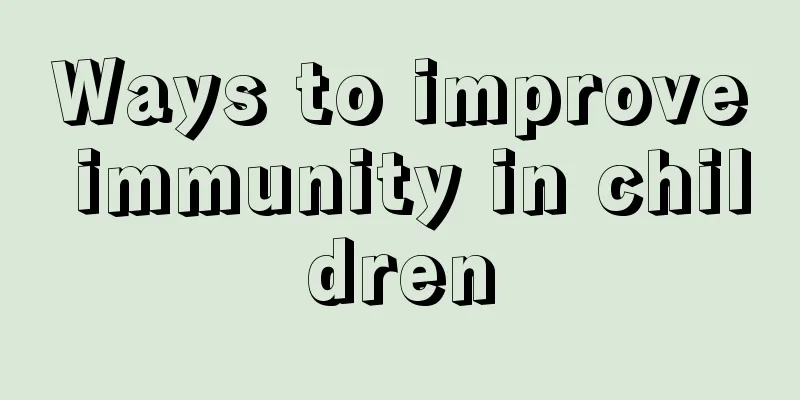What to do if your 10-month-old baby sneezes and has a runny nose

|
It is a very common phenomenon for ten-month-old babies to sneeze and have a runny nose. The main reason for this phenomenon is that the baby has cold symptoms. A cold is a disease that can cause great discomfort to children, so parents must take their children to the hospital for treatment in time. In addition, in daily life, parents must also take good care of their babies to prevent them from being infected by various diseases.
It can be caused by various viruses and bacteria, but more than 90% are viruses, mainly rhinovirus, respiratory syncytial virus, influenza virus, parainfluenza virus, adenovirus, etc. Viral infection may be followed by bacterial infection, the most common of which is hemolytic streptococcus, followed by Streptococcus pneumoniae, Haemophilus influenzae, etc. In recent years, Mycoplasma pneumoniae has also become uncommon. Infants and young children are susceptible to this disease due to the anatomical and immune characteristics of the upper respiratory tract. Nutritional disorders, such as vitamin D deficiency rickets, subclinical vitamin A, zinc or iron deficiency, or improper care, climate change and adverse environmental factors, can easily lead to recurrent upper respiratory tract infections or prolong the course of the disease. 2. Diagnosis 1. The symptoms of many acute infectious diseases are similar to those of colds, so when making a diagnosis, you can make it based on the local epidemic situation to increase the diagnosis rate. 2. Perform a full physical examination, focusing on the entire pharynx, which includes the tonsils, soft palate, and posterior pharyngeal wall. The tonsils and pharyngeal mucosa appear severely red and swollen, and the tonsils may have purulent secretions.
1. General treatment For patients with viral infections, their families should be informed of the self-limiting nature of the disease and the purpose of treatment: to prevent cross infection and complications. Pay attention to rest, maintain a good surrounding environment, drink plenty of water and supplement plenty of vitamin C, etc. 2. Anti-infection treatment (1) Antiviral drugs Most upper respiratory tract infections are caused by viruses. You can try triazole nucleoside (ribavirin), either orally or intravenously. You can also try pansantin, with a course of treatment of 3 days. (2) Antibiotics Bacterial upper respiratory tract infection or viral upper respiratory tract infection secondary to bacterial infection can be treated with antibiotics, usually penicillins, co-trimoxazole and macrolide antibiotics. Positive throat swab culture results help guide antimicrobial therapy. If it is confirmed to be a streptococcal infection, or if there is a history of rheumatic fever or nephritis, the penicillin treatment course should be 10 to 14 days.
(1) For high fever, you can take acetaminophen or ibuprofen orally, or use cold compresses, warm compresses, or alcohol baths to reduce the temperature. (2) Patients who experience febrile convulsions can be given sedatives and anticonvulsant treatments. (3) For sore throat, you can take throat lozenges sublingually (older children). (4) Chinese patent medicines also have good effects. |
<<: How to judge your baby's intelligence
>>: Baby's eye mucus is so yellow, what's going on?
Recommend
Is it normal for a baby to nod and breathe?
Newborns have very weak constitutions and are pro...
What causes a tickle in my child's throat?
Throat itching and coughing is a very common dise...
Tips for children to sleep in separate rooms
For parents, children's education plays a ver...
Symptoms of pharyngitis in 10-year-old children
Many people think that only adults suffer from ph...
Six-month-old baby development standard
In fact, in daily life, we must be very careful t...
Causes of yellow eyes in babies
Many babies have yellow eyes, which makes many pa...
Is it normal for a newborn to have cold hands and feet?
The resistance of newborns is very weak, and we n...
When is the best time for young children to brush their teeth?
Many times, first-time mothers wonder at what age...
What happens if I get the thrush vaccination?
Thrush is a common disease among newborns, and it...
Will children get angry if they drink pure milk?
For a child, parents pay attention to him all the...
What are the symptoms of infantile thrush?
Ratworms are in people's intestines and can s...
How to prevent the sequelae of fever and convulsions in children?
Children's fever must be treated promptly, ot...
What is the cause of a sudden fever in a child?
It is a common situation for parents that their c...
Should I cover my child with a blanket when he has a high fever?
Fever is a disease in which the human body temper...
Can I give my child a bath when he has a fever?
Because babies have weak body resistance, they of...









